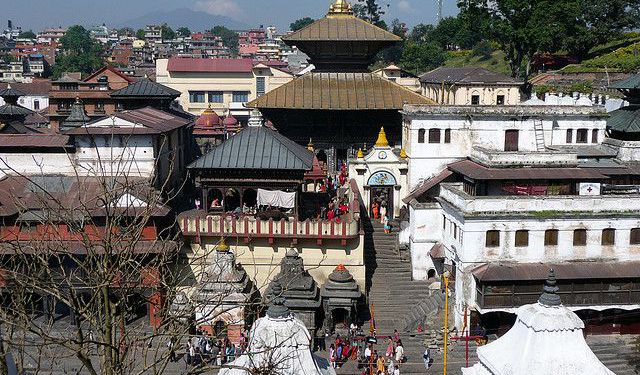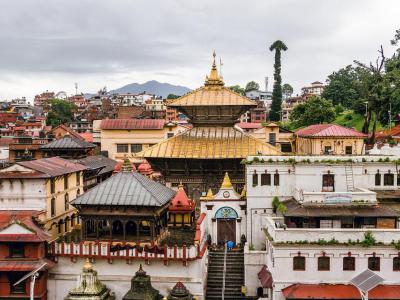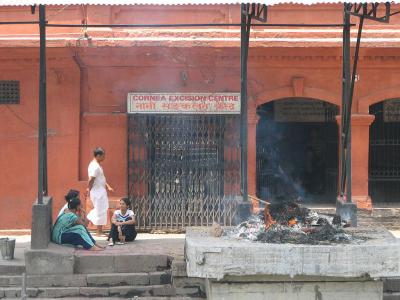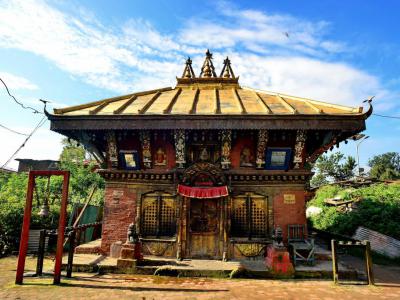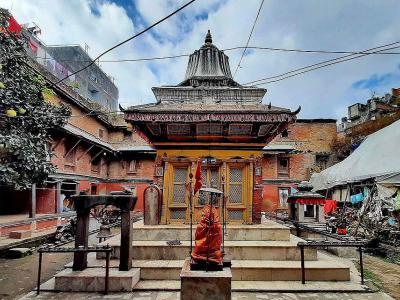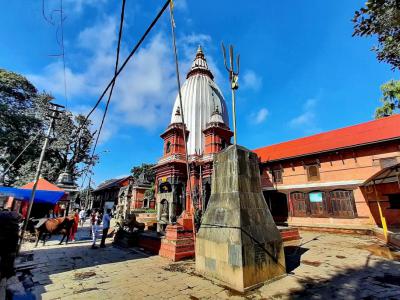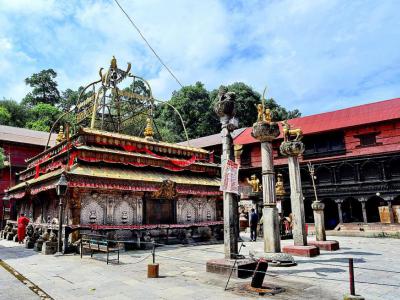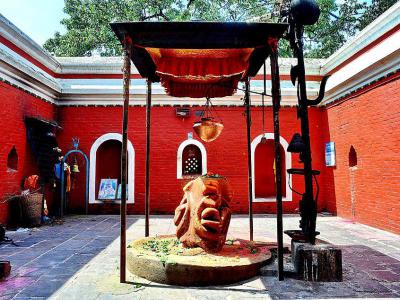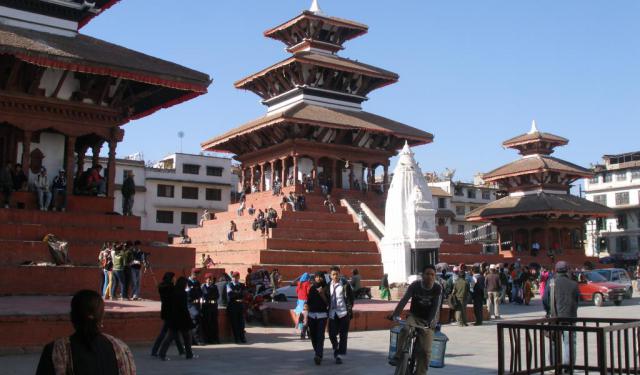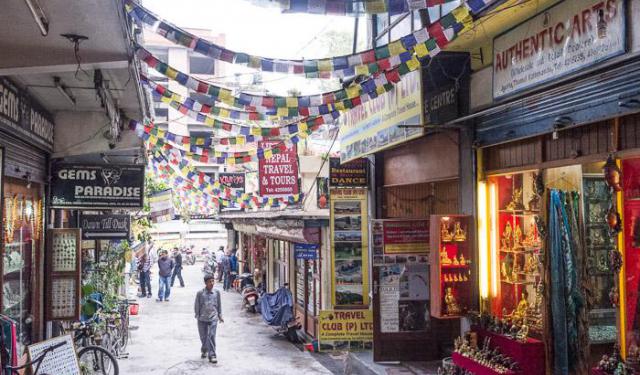Pashupatinath Temple Complex Tour (Self Guided), Kathmandu
Pashupatinath Temple Complex in Kathmandu is a sacred religious site that holds great significance for Hindus worldwide. The area in which it is located, near the Tribhuvan International Airport, is truly picturesque - surrounded by virgin jungle. This complex encompasses several notable locations, each contributing to its spiritual and cultural importance.
At the heart of the complex stands the Pashupatinath Temple, dedicated to Lord Shiva, one of the principal deities in Hinduism. The temple's architecture, adorned with intricate wood carvings and silver-plated doors, reflects the Nepali pagoda style and is a stunning example of ancient craftsmanship.
Adjacent to the temple are the Cremation Ghats, where Hindus cremate their deceased loved ones as a final farewell ritual. The smoke rising from the pyres creates a solemn yet spiritually significant atmosphere, reminding visitors of the cycle of life and death.
The Raj Rajeshwari Temple, located within the complex, is dedicated to Goddess Raj Rajeshwari, another revered deity in Hinduism. Devotees come here seeking blessings for their families and well-being.
The Ram Mandir, or Ram Temple, is another integral part of the complex, dedicated to Lord Rama, an important figure in Hindu mythology. It stands as a symbol of devotion and faith.
The Gorakhnath Mandir, honoring Gorakhnath, a prominent yogi and saint, attracts yogis and spiritual seekers searching for enlightenment and blessings.
The Guhyeshwari Temple is dedicated to Goddess Guhyeshwari, who is considered one of the divine forms of Goddess Parvati. Devotees visit this temple to seek blessings for marital harmony and fertility.
Lastly, the Kirateshwar Mahadev, or Kirateshwar Temple, is dedicated to Lord Shiva in his form as Kirateshwar, associated with the epic Mahabharata. Pilgrims come here to pay homage to Lord Shiva and seek spiritual enlightenment.
Being both a religious site and a cultural and historical treasure of Kathmandu, the Pashupatinath Temple Complex offers a unique glimpse into the spiritual practices of Hinduism. While immersing themselves in this beautiful enclave, visitors are urged to respect the sanctity of the place. A visit here is a spiritual journey and a way to connect with the deep-rooted traditions of Nepal.
At the heart of the complex stands the Pashupatinath Temple, dedicated to Lord Shiva, one of the principal deities in Hinduism. The temple's architecture, adorned with intricate wood carvings and silver-plated doors, reflects the Nepali pagoda style and is a stunning example of ancient craftsmanship.
Adjacent to the temple are the Cremation Ghats, where Hindus cremate their deceased loved ones as a final farewell ritual. The smoke rising from the pyres creates a solemn yet spiritually significant atmosphere, reminding visitors of the cycle of life and death.
The Raj Rajeshwari Temple, located within the complex, is dedicated to Goddess Raj Rajeshwari, another revered deity in Hinduism. Devotees come here seeking blessings for their families and well-being.
The Ram Mandir, or Ram Temple, is another integral part of the complex, dedicated to Lord Rama, an important figure in Hindu mythology. It stands as a symbol of devotion and faith.
The Gorakhnath Mandir, honoring Gorakhnath, a prominent yogi and saint, attracts yogis and spiritual seekers searching for enlightenment and blessings.
The Guhyeshwari Temple is dedicated to Goddess Guhyeshwari, who is considered one of the divine forms of Goddess Parvati. Devotees visit this temple to seek blessings for marital harmony and fertility.
Lastly, the Kirateshwar Mahadev, or Kirateshwar Temple, is dedicated to Lord Shiva in his form as Kirateshwar, associated with the epic Mahabharata. Pilgrims come here to pay homage to Lord Shiva and seek spiritual enlightenment.
Being both a religious site and a cultural and historical treasure of Kathmandu, the Pashupatinath Temple Complex offers a unique glimpse into the spiritual practices of Hinduism. While immersing themselves in this beautiful enclave, visitors are urged to respect the sanctity of the place. A visit here is a spiritual journey and a way to connect with the deep-rooted traditions of Nepal.
How it works: Download the app "GPSmyCity: Walks in 1K+ Cities" from Apple App Store or Google Play Store to your mobile phone or tablet. The app turns your mobile device into a personal tour guide and its built-in GPS navigation functions guide you from one tour stop to next. The app works offline, so no data plan is needed when traveling abroad.
Pashupatinath Temple Complex Tour Map
Guide Name: Pashupatinath Temple Complex Tour
Guide Location: Nepal » Kathmandu (See other walking tours in Kathmandu)
Guide Type: Self-guided Walking Tour (Sightseeing)
# of Attractions: 7
Tour Duration: 1 Hour(s)
Travel Distance: 1.8 Km or 1.1 Miles
Author: helenp
Sight(s) Featured in This Guide:
Guide Location: Nepal » Kathmandu (See other walking tours in Kathmandu)
Guide Type: Self-guided Walking Tour (Sightseeing)
# of Attractions: 7
Tour Duration: 1 Hour(s)
Travel Distance: 1.8 Km or 1.1 Miles
Author: helenp
Sight(s) Featured in This Guide:
- Pashupatinath Temple
- Cremation Ghats
- Raj Rajeshwari Temple
- Ram Mandir (Ram Temple)
- Gorakhnath Mandir (Gorakhnath Temple)
- Guhyeshwari Temple
- Kirateshwar Mahadev (Kirateshwar Temple)
1) Pashupatinath Temple (must see)
Pashupatinath Temple is a pagoda-style temple, dedicated to the god Shiva, one of the main deities of Hinduism. Pashupatinath Temple was named a UNESCO World Heritage Site in 1979.
The exact date of construction is uncertain. There are references to it as early as the year 400. It is also said that the temple was built by the Licchavi king, Prachanda Deva. The current design of the temple dates to about 1692.
Pashupatinath Temple was built in the Nepalese pagoda style. It has a two-level copper roof covered in gold. The main doors are silver, and the pinnacle is gold. The main idol is a three-foot stone obelisk with a silver base. It has faced each direction representing the different aspects of Shiva.
The original temple is the oldest construction in the Vaishnava temple complex. Other temples were built around it, including the 11th-century Guhyeshwari Temple and a 14th-century Rama Temple. However, even surrounded by other temples, Pashupatinath Temple's two stories stand above them as the center and focus of the complex.
Not only is Pashupatinath Temple the oldest in the complex, but it is also the oldest Hindu temple in Kathmandu. It was reconstructed by King Shivadeva in the 2nd century and was later renovated by the ruler Ananta Malla, who added a roof to the structure.
Visitors can attend the daily rituals that take place at Pashupatinath Temple. The rituals are carried out by two groups of priests, who are the only people allowed to perform puja rituals (a worship ritual to offer devotional homage and prayer to one or more deities) or touch the idol.
The exact date of construction is uncertain. There are references to it as early as the year 400. It is also said that the temple was built by the Licchavi king, Prachanda Deva. The current design of the temple dates to about 1692.
Pashupatinath Temple was built in the Nepalese pagoda style. It has a two-level copper roof covered in gold. The main doors are silver, and the pinnacle is gold. The main idol is a three-foot stone obelisk with a silver base. It has faced each direction representing the different aspects of Shiva.
The original temple is the oldest construction in the Vaishnava temple complex. Other temples were built around it, including the 11th-century Guhyeshwari Temple and a 14th-century Rama Temple. However, even surrounded by other temples, Pashupatinath Temple's two stories stand above them as the center and focus of the complex.
Not only is Pashupatinath Temple the oldest in the complex, but it is also the oldest Hindu temple in Kathmandu. It was reconstructed by King Shivadeva in the 2nd century and was later renovated by the ruler Ananta Malla, who added a roof to the structure.
Visitors can attend the daily rituals that take place at Pashupatinath Temple. The rituals are carried out by two groups of priests, who are the only people allowed to perform puja rituals (a worship ritual to offer devotional homage and prayer to one or more deities) or touch the idol.
2) Cremation Ghats
Cremation Ghats are located along the banks of the sacred Bagmati River near the Pashupatinath Temple.
The Cremation Ghats are used for funeral rites. They are known as the city's most important ghats in Kathmandu. Visitors are welcome to sit by the river and watch while the last rites are performed.
Funerals for Nepali citizens take place on the southern side of the temple. Their bodies are first cleansed with sacred camphor and wrapped in shrouds. They are then laid out on the riverbank.
There are six elevated platforms for open cremation. The body is placed on one of these and then cremated on a wooden pyre. The process takes about three to four hours.
Cremations have been taking place at these cremation ghats for hundreds of years. The belief is that a Hindu who is cremated at Pashupatinath Temple is destined to be reborn human in the next life.
The Cremation Ghats are used for funeral rites. They are known as the city's most important ghats in Kathmandu. Visitors are welcome to sit by the river and watch while the last rites are performed.
Funerals for Nepali citizens take place on the southern side of the temple. Their bodies are first cleansed with sacred camphor and wrapped in shrouds. They are then laid out on the riverbank.
There are six elevated platforms for open cremation. The body is placed on one of these and then cremated on a wooden pyre. The process takes about three to four hours.
Cremations have been taking place at these cremation ghats for hundreds of years. The belief is that a Hindu who is cremated at Pashupatinath Temple is destined to be reborn human in the next life.
3) Raj Rajeshwari Temple
The Raj Rajeshwari Temple, situated in the revered Pashupatinath temple area of Kathmandu, represents the country's rich cultural and religious heritage. Located on the south bank of the Bagmati River, it serves as a significant center for worship and spirituality, attracting visitors and devotees from various regions of Nepal and beyond.
Built in 1464 BS during the reign of Jayadharma Malla and Jagyoti Malla, the Raj Rajeshwari Temple showcases the classic Nepalese pagoda style of architecture. The temple's design features intricate woodwork that highlights traditional Nepalese craftsmanship. At its core is a life-sized statue of Nava Durga, made from clay on all four sides, reflecting the temple's profound spiritual importance.
The temple, also known as the residence of the Tantric Goddess, upholds a tradition of conducting special worship ceremonies on every full moon day, emphasizing its integral role in the spiritual life of the local community.
Its history is intertwined with stories from the Devmala genealogy, including the revelation of the mysterious idol by King Bishnugupta, who then constructed a new earthen fort for rituals, marking a significant moment in the temple's history.
Visitors are encouraged to embark on a spiritual journey beyond the temple premises, participating in rituals such as offering water in the Brahmanal of the eastern Aryaghat after paying homage to the goddesses.
The temple complex, not limited to the Raj Rajeshwari Temple alone, comprises various other temples, each with its significance and deities, reflecting Nepal's diverse religious landscape and providing a holistic spiritual experience to all visitors.
Built in 1464 BS during the reign of Jayadharma Malla and Jagyoti Malla, the Raj Rajeshwari Temple showcases the classic Nepalese pagoda style of architecture. The temple's design features intricate woodwork that highlights traditional Nepalese craftsmanship. At its core is a life-sized statue of Nava Durga, made from clay on all four sides, reflecting the temple's profound spiritual importance.
The temple, also known as the residence of the Tantric Goddess, upholds a tradition of conducting special worship ceremonies on every full moon day, emphasizing its integral role in the spiritual life of the local community.
Its history is intertwined with stories from the Devmala genealogy, including the revelation of the mysterious idol by King Bishnugupta, who then constructed a new earthen fort for rituals, marking a significant moment in the temple's history.
Visitors are encouraged to embark on a spiritual journey beyond the temple premises, participating in rituals such as offering water in the Brahmanal of the eastern Aryaghat after paying homage to the goddesses.
The temple complex, not limited to the Raj Rajeshwari Temple alone, comprises various other temples, each with its significance and deities, reflecting Nepal's diverse religious landscape and providing a holistic spiritual experience to all visitors.
4) Ram Mandir (Ram Temple)
Ram Mandir in Kathmandu is a distinguished Hindu temple prominently situated on the east bank of the sacred Bagmati River. Constructed in 1871 by Sanak Singh Tondon, this temple spans an area that once measured 374 ropanies, reduced now to just 2.75 ropanies. The temple complex is historically significant, noted for its unique Domb architectural style-a rarity in Nepal-which beautifully integrates elements of Royal Gombaz and Mughal architecture, reflective of the historical Mughal influence in the region.
Dedicated to the deities of Lord Rama, Goddess Sita, and Lord Hanuman, Ram Mandir stands out as one of the finest Ram temples in Nepal due to its splendid interiors and the presence of idols not only of Rama and Sita but also of Rama's brothers-Lakshman, Bharat, and Shatrughan. The temple's black stone idols, all facing east, are complemented by an array of artistic objects and a renowned idol of Hanuman located on the temple's eastern side.
The temple's interior is adorned with murals, and miniature and easel paintings that depict various episodes from the Ramayana, enhancing its spiritual and cultural ambiance. Notably, the temple also housed 32 sculptures of fairies with butterfly wings, which contributed to the area's name, Battisputali, meaning "32 butterflies."
Located a short distance from the Pashupatinath Temple and featuring a viewing platform overlooking this famous site, Ram Mandir is not only a place of worship but also a cultural hub. It hosts classical music concerts every full moon evening, inviting a broader audience to partake in its serene and spiritual environment. Remarkably, Ram Mandir is one of the few temples in Kathmandu that welcomes followers of all religions to participate in aarti and experience the divine presence within its walls.
Dedicated to the deities of Lord Rama, Goddess Sita, and Lord Hanuman, Ram Mandir stands out as one of the finest Ram temples in Nepal due to its splendid interiors and the presence of idols not only of Rama and Sita but also of Rama's brothers-Lakshman, Bharat, and Shatrughan. The temple's black stone idols, all facing east, are complemented by an array of artistic objects and a renowned idol of Hanuman located on the temple's eastern side.
The temple's interior is adorned with murals, and miniature and easel paintings that depict various episodes from the Ramayana, enhancing its spiritual and cultural ambiance. Notably, the temple also housed 32 sculptures of fairies with butterfly wings, which contributed to the area's name, Battisputali, meaning "32 butterflies."
Located a short distance from the Pashupatinath Temple and featuring a viewing platform overlooking this famous site, Ram Mandir is not only a place of worship but also a cultural hub. It hosts classical music concerts every full moon evening, inviting a broader audience to partake in its serene and spiritual environment. Remarkably, Ram Mandir is one of the few temples in Kathmandu that welcomes followers of all religions to participate in aarti and experience the divine presence within its walls.
5) Gorakhnath Mandir (Gorakhnath Temple)
Gorakhnath Mandir, nestled atop a hill in Kathmandu, is accessed through a winding stone staircase. Among the numerous temples in the area, Gorakhnath Mandir stands out for its distinctive architecture-a red-and-white structure with a striking white pagoda and a tall spire resembling a corn cob. A notable feature near the temple is a golden trident, which serves as a favored backdrop for photographs.
Historically, the temple is steeped in royal connections and spiritual significance. It was constructed by Jayasthiti Malla, a 4th-century king of Nepal, though some sources attribute its construction to Prithvi Narayan Shah. Dedicated to the revered Hindu saint Gorakhnath, the founder of Hatha yoga, the temple serves as a beacon for devotees of Hinduism, particularly attracting Brahmans and Chhetris.
The ambiance of Gorakhnath Mandir is one of serenity, embraced by nature with numerous trees and a resident population of macaques. The area is meticulously maintained, enhancing its status as a tranquil retreat. At night, the temple transforms with colorful lights, adding to its mystical allure.
In addition to the temple, the nearby Gorakhnath Cave is another point of interest, especially significant during Baisakh Purnima when a large fair is held, drawing many pilgrims and visitors. This period highlights the temple's role as a vital pilgrimage site within the Hindu community.
Gorakhnath Mandir, with its rich history, spiritual importance, and natural beauty, is not only a pivotal pilgrimage site but also a fascinating destination for both spiritual seekers and general tourists visiting Kathmandu.
Historically, the temple is steeped in royal connections and spiritual significance. It was constructed by Jayasthiti Malla, a 4th-century king of Nepal, though some sources attribute its construction to Prithvi Narayan Shah. Dedicated to the revered Hindu saint Gorakhnath, the founder of Hatha yoga, the temple serves as a beacon for devotees of Hinduism, particularly attracting Brahmans and Chhetris.
The ambiance of Gorakhnath Mandir is one of serenity, embraced by nature with numerous trees and a resident population of macaques. The area is meticulously maintained, enhancing its status as a tranquil retreat. At night, the temple transforms with colorful lights, adding to its mystical allure.
In addition to the temple, the nearby Gorakhnath Cave is another point of interest, especially significant during Baisakh Purnima when a large fair is held, drawing many pilgrims and visitors. This period highlights the temple's role as a vital pilgrimage site within the Hindu community.
Gorakhnath Mandir, with its rich history, spiritual importance, and natural beauty, is not only a pivotal pilgrimage site but also a fascinating destination for both spiritual seekers and general tourists visiting Kathmandu.
6) Guhyeshwari Temple
Guhyeshwari Temple is a revered Hindu temple dedicated to Guhyeshwari, the goddess of cosmic energy. It is an important pilgrimage site for Hindus.
The temple is located on the southern bank of the sacred Bagmati River. The goddess is also represented by water. The center of the temple has a water jar placed over a natural spring. Water seeps from the edges of the silver-and-gold jar, used by worshipers to honor the goddess.
The temple is open 24 hours. Visitors are welcome to explore the temple or worship the goddess. There are also classical music concerts at Guhyeshwari Temple every new moon.
Guhyeshwari Temple is important to Tantric worshipers as it is the best place to gain the power of Tantra (a Hindu and Buddhist philosophy). Many Tantric rites are performed at Guhyeshwari Temple. Newar Buddhists, the historical inhabitants of the Kathmandu Valley, also revere the shrine as they believe it to be the location of the root of the lotus from which the sacred site Swayambhunath sprang.
The temple is located on the southern bank of the sacred Bagmati River. The goddess is also represented by water. The center of the temple has a water jar placed over a natural spring. Water seeps from the edges of the silver-and-gold jar, used by worshipers to honor the goddess.
The temple is open 24 hours. Visitors are welcome to explore the temple or worship the goddess. There are also classical music concerts at Guhyeshwari Temple every new moon.
Guhyeshwari Temple is important to Tantric worshipers as it is the best place to gain the power of Tantra (a Hindu and Buddhist philosophy). Many Tantric rites are performed at Guhyeshwari Temple. Newar Buddhists, the historical inhabitants of the Kathmandu Valley, also revere the shrine as they believe it to be the location of the root of the lotus from which the sacred site Swayambhunath sprang.
7) Kirateshwar Mahadev (Kirateshwar Temple)
Kirateshwar Temple is a Sikh place of worship located on the west side of the sacred Bagmati River. It is dedicated to Lord Shiva. In the Shaivite tradition, Shiva is the Supreme Lord who creates, protects, and transforms the universe. The temple is locally known as Shiv Mandir (Shiva Temple).
According to Hindu beliefs, Lord Shiva appeared at this site and blessed Arjuna, the main character in ancient Hindu texts, with success in war, and then a temple was built in Lord Shiva's honor.
The ancient temple sits on a mountain across from the city of Gaurighat. Built in the traditional Nepali pagoda-style architecture with an open roof, it is one of the largest temple complexes in Sikhism.
The temple is open to the public 24 hours per day. Traditional Nepali concerts are held at night when the moon is full. Lord Shiva is the patron deity of Music and Arts, therefore the concerts bring many spectators and musicians from all over Nepal.
According to Hindu beliefs, Lord Shiva appeared at this site and blessed Arjuna, the main character in ancient Hindu texts, with success in war, and then a temple was built in Lord Shiva's honor.
The ancient temple sits on a mountain across from the city of Gaurighat. Built in the traditional Nepali pagoda-style architecture with an open roof, it is one of the largest temple complexes in Sikhism.
The temple is open to the public 24 hours per day. Traditional Nepali concerts are held at night when the moon is full. Lord Shiva is the patron deity of Music and Arts, therefore the concerts bring many spectators and musicians from all over Nepal.
Walking Tours in Kathmandu, Nepal
Create Your Own Walk in Kathmandu
Creating your own self-guided walk in Kathmandu is easy and fun. Choose the city attractions that you want to see and a walk route map will be created just for you. You can even set your hotel as the start point of the walk.
Kathmandu Introduction Walking Tour
Kathmandu is the capital city of Nepal. With nearly 3 million residents in the metropolitan region, Kathmandu is also the largest city in the country. Kathmandu is notable for being one of the oldest continuously inhabited cities in the world.
The name "Kathmandu" comes from the name of the Kasthamanadap pavilion in Durbar Square. That name comes from the Sanskrit words for... view more
Tour Duration: 2 Hour(s)
Travel Distance: 2.9 Km or 1.8 Miles
The name "Kathmandu" comes from the name of the Kasthamanadap pavilion in Durbar Square. That name comes from the Sanskrit words for... view more
Tour Duration: 2 Hour(s)
Travel Distance: 2.9 Km or 1.8 Miles
Kathmandu's Street Markets Tour
Ardent shoppers – those keen on street markets in particular – will find Kathmandu a true heaven. In this city, street markets are where you can buy some exotic (and often good-quality) products, such as monk's robes, soft silks, woolen garments, artifacts, and more, at very good prices. The list of bargains is truly endless. Sadly, however, in Kathmandu, you are not allowed to buy... view more
Tour Duration: 1 Hour(s)
Travel Distance: 2.2 Km or 1.4 Miles
Tour Duration: 1 Hour(s)
Travel Distance: 2.2 Km or 1.4 Miles
The Most Popular Cities
/ view all
